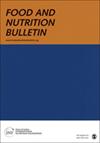设计基于具体情况的食品战略,改善乌干达中部农村农户儿童的膳食多样性
IF 1.6
4区 医学
Q3 FOOD SCIENCE & TECHNOLOGY
引用次数: 0
摘要
背景:在以农业为生的社区,以食物为基础的策略在改善饮食质量和降低营养缺乏症发病率方面具有很大的潜力。结果:确定的优先行为和环境决定因素与食品生产、消费和功效有关,而个人决定因素则侧重于知识、技能、自我效能、态度和结果预期。由此制定的战略旨在改善多样化食品的供应、获取和消费,尤其侧重于生产多样性、生产实践、市场准入和市场多样性。选择了改变行为的方法,以提高能力和自我效能、制定战略目标和提供反馈。该战略侧重于家庭小组的学习、示范、实践和社会支持。验证结果表明,战略中包含的决定因素和参与者对于提高农村农户和社区的生产率、粮食供应、膳食多样性、生计和健康具有重要意义和相关性。本文章由计算机程序翻译,如有差异,请以英文原文为准。
Designing a Contextualized Food-Based Strategy to Improve the Dietary Diversity of Children in Rural Farming Households in Central Uganda
Background:Food-based strategies have a high potential of improving the diet quality and reducing the prevalence of nutrient deficiencies in agriculture-dependent communities. Their design is however complex with trade-offs that are rarely systematically presented to allow replication and efficient contextualization.Objective:The systematic design of a food-based strategy to improve the dietary diversity of children in rural farming communities in Uganda.Methods:The intervention mapping protocol was used to provide a systematic approach to developing theory-based and evidence-based intervention methods and strategy.Results:The priority behavioral and environmental determinants identified were related to food production, consumption, and efficacy while the personal determinants focused on knowledge, skills, self-efficacy, attitude, and outcome expectations. The aim of the resulting strategy was set to improve the availability, accessibility, and consumption of diverse foods, with a particular focus on production diversity, production practices, market access, and market diversity. Behaviour change methods were selected to enhance ability and self-efficacy, strategic goal setting, and provision of feedback. The strategy focused on household groups for learning, demonstration, practice, and social support. The validation showed that the determinants and actors incorporated in the strategy were important and relevant for improving the productivity, food availability, dietary diversity, livelihoods, and health of rural farming households and communities.Conclusion:Application of the protocol yielded a contextualized food-based strategy that can be adjusted for use in other smallholder contexts in developing countries by piloting implementation plans based on the strategy; reassessing the key determinants and implementing the revised strategy; or replicating the whole design process.
求助全文
通过发布文献求助,成功后即可免费获取论文全文。
去求助
来源期刊

Food and Nutrition Bulletin
工程技术-食品科技
CiteScore
4.10
自引率
0.00%
发文量
31
审稿时长
18-36 weeks
期刊介绍:
The Food and Nutrition Bulletin (FNB,) is a peer-reviewed, academic journal published quarterly by the Nevin Scrimshaw International Nutrition Foundation. The Journal is one of the leading resources used by researchers, academics, nutrition policy makers and planners in over 125 countries to obtain the most current research and policy information related to nutrition in developing countries.
 求助内容:
求助内容: 应助结果提醒方式:
应助结果提醒方式:


